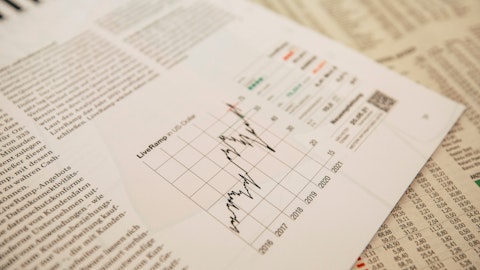Finally, on our Generation 3 CSP product, we expect the first deployment to be mechanically complete by the end of 2025, allowing us to showcase the first integrated next-generation solar thermal energy product using our novel particle technology for heat storage. We have an exceptional team leading our approach to integration and design that allows us to create scalable, flexible, concentrated solar thermal modules and gives us an opportunity to further expand margins of licensing and O&M. We also have strong partnerships with companies like Sener, Worley and Hanwha, who have deep relevant experience on an existing CSP technology that we’re deploying for the first time along with Woodside Energy. In sum, this plan for our planned integration slides of value creation, puts us well underway to accumulate operating experience that sets us up for supporting a performance guarantee that will help us continue to drive commercial engagement and bolster our industry-leading intellectual property.
All of that will reinforce the momentum around our commercial pipeline, which you’ll see on slide eight is now at 1.8 gigawatts. Now, last time, we presented a similar page to you and thought it would be important at this time to update you on the anatomy of our growing pipeline. We’ve increased our lead generation from 825 megawatts to 1.8 gigawatts, which is more than double. We’ve also seen an improvement in megawatts across the first three buckets, although not a similar increase in number of customers, which means that we’re seeing traction on larger-scale projects relative to last quarter. We’ve increased our submitted proposals by 20 megawatts, and a few of our submitted proposals have transitioned to our pre-FID activities going from 20 to 65 megawatts.
Although our booked orders remain the same, like we talked about last time, it can be an 18-month process for items and lead generation to transition to booked orders, and we’re taking all the right steps to get there. We do expect some of these pre-FID activities to manifest in the form of FEED studies and joint development agreements towards the contractual activity that we expect to round out our 2023 goal of closing sales. Moving to slide nine. Our pipeline spans across many of the industries that we’ve talked to you about, which is beneficial as we are not significantly exposed to any one major macroeconomic factor. For example, metals and mining customers are critical in the energy transition, and they’re aggressively seeking to decarbonize given the focus on upstream environmental impact.
Oil and gas are also experiencing record-high profit given the recent increase in energy prices, and they, too are looking to put some of those profits to work on meeting decarbonization goals. Our pipeline is also global in nature, particularly where solar resource is strong and where CSP is a well-understood technology. And as you might expect, because we started our real commercial progress only earlier this year, many of the CODs are commercial operating days for our projects that we’re currently evaluating are in 2026 and beyond, which is what you would expect to see for a company that is where we are in our commercial journey. Moving to slide 10. I want to highlight the interest in our new hybrid power product and explain why it is so exciting for our mission.
One compelling aspect of our power product is that it can be dispatchable over long duration, including during the times when traditional solar is waning while power demand is spiking. And the second compelling aspect is that our modularity can help minimize reliance on the existing transmission system because we can generate power on or adjacent to a customer’s premises or major industrial demand centers. Despite our commercializing this product only earlier this year, it now represents the vast majority of our pipeline, about 80% of our projects. On slide 11, you can see the trend in power prices, as shown by this example, for CAISO, which is the independent system operator that oversees the operation of California’s bulk electric power system, transmission lines, and the electricity market generated and transmitted by its member utilities.
What you see on this graph is the price of energy for a particular year over a 24-hour period, but the bottom trend line showing 2020 pricing. As you go up in order of time on these graphs, it shows how pricing has increased from 2020 to 2023 and the predicted pricing case for 2030. These prices are continuing to rise due in large part to increasing natural gas prices, which have even more important of a firming source of power to back up intermittent renewable energy as well as due to the level of infrastructure investment required to modernize the grid and ensure reliable power delivery. These trends underscore the importance of dispatchable clean energy and why we believe our dispatchable power product is seeing traction. Building on this further, slide 12 shows what is happening for fossil fuel power plants across the US.
The example on this slide is a valve natural gas plants that have been built over the last 30 years and the forecasted natural gas plant retirements that are expected over the next 30 years from where we sit today in 2023. The ones that are retiring far outweigh what is being built. We’re seeing the emergence of some temporary gas generators at existing power plant sites in order to avoid blackouts and boost grid stability. And these are taking us backwards on the decarbonization trajectory; therein lies our opportunity to come in with cost-effective, dispatchable clean power using our concentrated solar energy technology and hybrid offerings. Now, let me move to slide 13. You’ll see us build on to this slide further, and so I’m going to take you through it step by step.




